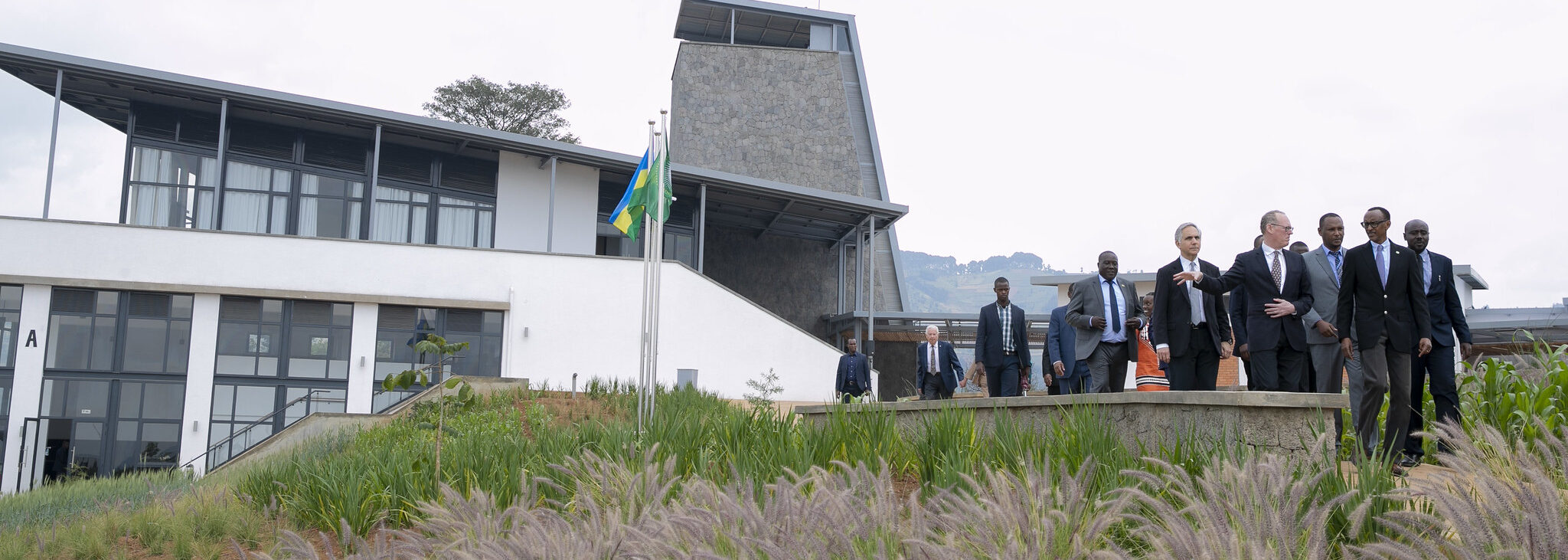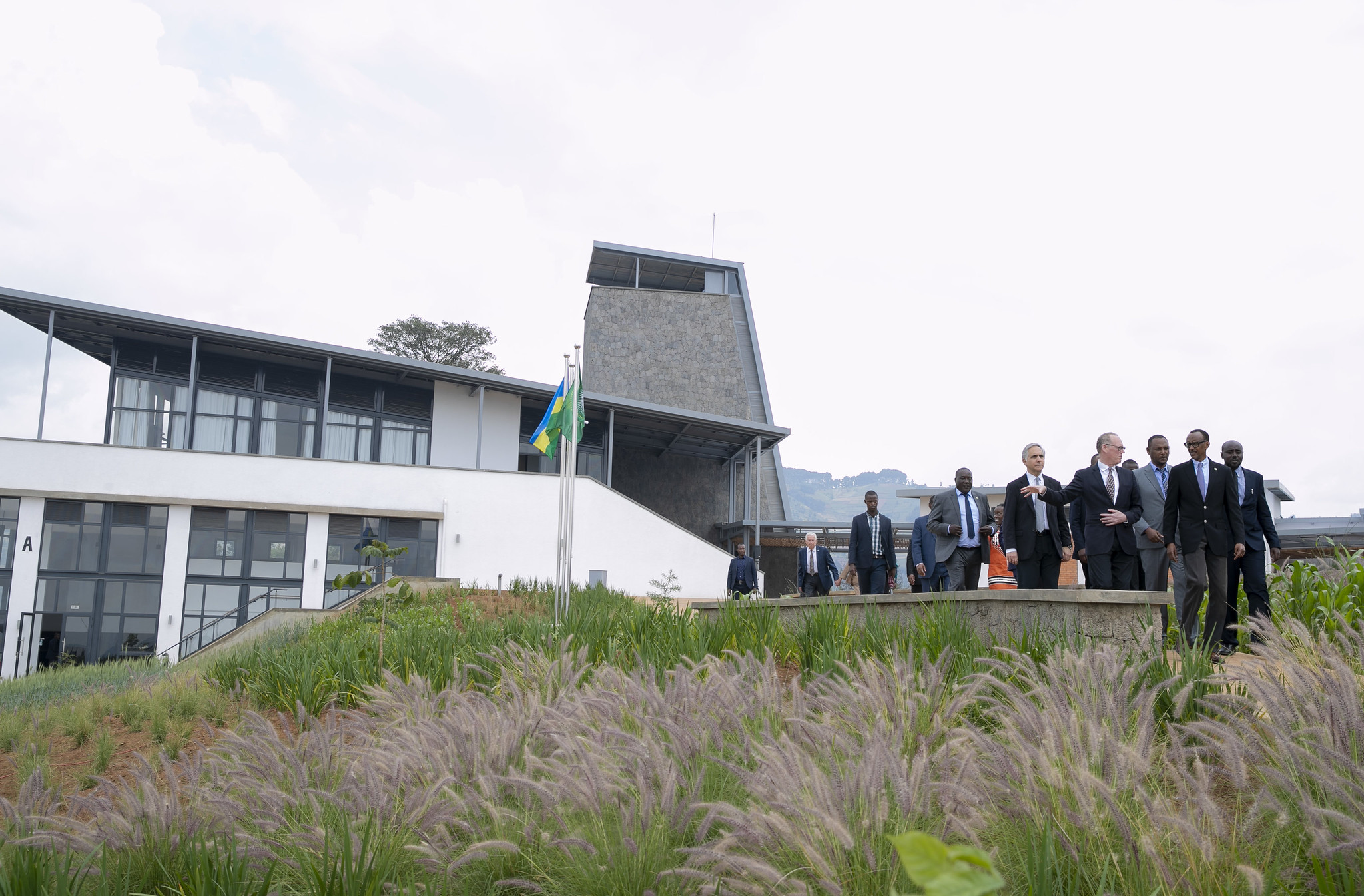Published: 05/12/2023
By Jamie Hansen, Global Health Communications Manager
A shared commitment to building healthcare capacity on the African continent and fostering global health equity has brought together Stanford Medicine faculty and the leaders of a new and growing medical school in Rwanda.
The University of Global Health Equity (UGHE) launched in Butaro, Rwanda, in 2015, with a novel mission: “To change the way health care is delivered around the world by training the next generation of global health professionals to deliver more equitable, quality health services for all.” The burgeoning university is partnering with many globally minded medical schools, including Stanford, to provide high-quality education to its students and build teaching, technical, and clinical capacity in Rwanda and Eastern Africa more broadly.
Stanford global health leaders and faculty, inspired by the university’s mission and leadership, have responded to UGHE’s invitations for collaboration in a variety of ways, including mentoring faculty, teaching medical students, and supporting initiatives to expand technological capacity.
“The brainchild of two global health visionaries, Drs. Agnes Binagwaho and the late Dr. Paul Farmer, UGHE is on track to be one of the premier medical schools on the continent,” said Michele Barry, director of the Stanford Center for Innovation in Global Health and Shenson professor, who has served on UGHE’s member advisory council since 2018. Binagwaho is the retired vice chancellor of the university, former Rwandan minister of health, and a leading advocate for health equity. Paul Farmer was a global health equity leader and founder of the nonprofit Partners in Health, which helped launch UGHE.
“This idea, this place, and these people are paving the way for a better world for all of us,” said Brooke Cotter, Stanford clinical assistant professor of medicine. Cotter recently stepped into a new role as director of education and collaboration between the universities. “Being there is inspiring, and it makes you want to be a part of that vision.”
This idea, this place, and these people are paving the way for a better world for all of us.
Dr. Brooke Cotter
A Deepening Partnership
Since the university’s inception, Stanford faculty have been engaged in a variety of ways. However, these myriad efforts haven’t always been synchronized or coordinated. Cotter said she sees her role as identifying the current and potential collaborations between Stanford and UGHE to bring like-minded people together and build community between the institutions.
“There are so many wonderful people doing great things at both UGHE and Stanford,” she said. “The hope is that through coordination, we can cross-pollinate our efforts.”
UGHE-Stanford partnerships, focused on their new medical school, began at the university’s inception, shepherded by UGHE’s founding Dean of Medicine, Abebe Bekele, said Dr. Charles Prober. Prober, professor of pediatrics, microbiology, and immunology and senior associate vice provost for health education at Stanford Medicine. “Dean Abebe can pull many people into his tent from institutions around the world,” he said. As the medical school launched, Prober became chair of the Dean’s advisory committee that Bekele assembled. Inspired by an in-person visit to UGHE, Larry Katznelson, professor of neurosurgery and medicine (endocrinology) and associate dean of graduate medical education, also helped launch Stanford’s relationship with the university, Cotter said.
Dean Abebe can pull many people into his tent from institutions around the world.
Dr. Charles Prober
Many efforts have centered on mentorship and capacity-building: Prober helped build a faculty mentorship program that matched UGHE faculty with medical school faculty from institutions, including Stanford, University of Michigan, University of Nebraska, Georgetown, Northwestern, California University of Science & Medicine, and Harvard. Dr. Lars Osterberg, professor (teaching) of medicine and co-director of Stanford Medicine’s teaching and mentoring academy, has also mentored UGHE faculty and provided “teach the teacher” trainings to help expand the capacity of UGHE educators. Joe Becker, associate professor of emergency medicine, helped UGHE develop its emergency medicine curriculum.
Other initiatives have centered on expanding capacity and learning through technology.
Dean Bekele and Dr. Barnabas Alayande, a general surgeon and assistant professor of surgery at UGHE, reached out to Tom Weiser, MD, director of global engagement for Stanford Surgery, for help in developing a surgery curriculum and augmenting local teaching capacity. Weiser connected them with Cara Liebert, MD, FACS, and Dana Lin, MD, who had developed an innovative online platform for creating and deploying virtual patient simulation scenarios to teach and objectively assess surgical decision-making competence. With support from a CIGH seed grant and help from Martin Bronk, a general surgeon at Menlo Medical Clinic, and Drexel University Medical Student Tyler Wilson, they developed 16 surgical cases for UGHE students to learn through ENTRUST — all based on scenarios young physicians are most likely to encounter in Rwanda. The cases will be rolled out next fall.
Seeing the potential for digital health technology, UGHE has also formed a consortium to co-develop a comprehensive, integrated training curriculum to train stakeholders to become digital health leaders in Africa. The Stanford Center for Health Education, led by Prober, co-designed and co-facilitated the digital health leadership course as part of the university’s Digital Health Applied Leadership Program.
The university is now launching a new health technology innovation initiative, East Africa Biodesign, in partnership with Stanford Biodesign and the University of Rwanda’s Center of Excellence in Biomedical Engineering and eHealth. The program aims to strengthen the regional health technology ecosystem, to improve health outcomes, by teaching local innovators the biodesign innovation process, incubating trainee projects and providing entrepreneurship coaching by local domain experts and investors. The initiative launches with a virtual event on May 25.
Learning Together
A spirit of equal exchange and learning, or bidirectionality, is critical to the partnership, Cotter said. Stanford has much to learn from working with UGHE’s leaders as they create a new university from the ground up, she added.
In this spirit, Stanford Surgery’s Global Engagement initiative recently hosted Dr. Alayande as a scholarly guest on Stanford’s campus. He met with Stanford global health leaders and practitioners, shared his views on his institution’s most pressing needs, and proposed ideas for effective bidirectional programs.
“It is more and more clear that there is potential for more cross-cultural learning between the University of Global Health Equity and Stanford University on multiple levels,” he told Mohammed Al Kadim, Global Engagement Manager, for a story on their website.
It is more and more clear that there is potential for more cross-cultural learning between the University of Global Health Equity and Stanford University on multiple levels
Dr. Barnabas Alayande
Prober emphasized the potential for cross-cultural learning. “As I have conversations with medical schools in different parts of the world, I often reference how UGHE met a challenge or achieved a goal not in our particular way, but in their particular way, by aggregating their resources,” he said.
From Virtual to In-Person Connections
Cotter recently returned from her first in-person visit to UGHE to deepen the connections built over virtual correspondence during the pandemic and better understand the university’s needs.
Over the prior year, Cotter, Osterberg, and other faculty taught preclinical students through a virtual platform in an initiative supported by CIGH. As the first cohort of UGHE students advanced to their year of clinical rotations, Stanford faculty like Osterberg and Cotter, along with Global Health Track Resident Andrew Enslen, traveled to UGHE to serve as attending physicians on the internal medicine ward. This coincided with a visit by two Stanford surgery residents, Carlie Arbaugh and Jaclyn Wu, who spent three weeks with UGHE students on their surgery rotation conducting bedside teaching and holding surgical didactic sessions.
“I was incredibly excited to be able to work with the same students we had taught virtually over the last year,” Cotter said.
Cotter hopes to help identify a group of core faculty who can return year after year for two-week visits, deepening relationships and building familiarity between the universities.
Cotter encouraged any Stanford faculty or staff interested in getting involved with the UGHE partnership to contact her.
Cotter can be reached at bcotter@stanford.edu.
Main photo credit: University of Global Health Equity Inauguration (Burera) in 2019. Credit: Paul Kagame, via Flickr

